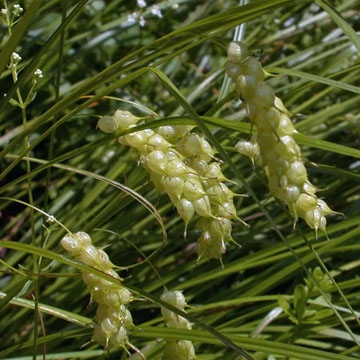

Carex tuckermanii - (image 1 of 3)
Taxonomy
Family: Cyperaceae
Section Vesicariae
Habitat
Swamp forests, thickets, wet meadows, stream or pond shores.
Associates
Distribution
New Brunswick to MN, south to NJ, OH, and IA.
Morphology
Tufted perennial from short rhizomes; stems 40-80 cm; leaves soft and flat, the main ones 20-40 cm long and 3-6 mm wide; lowest bracts 25-70 cm, exceeding the inflorescence; staminate spikes usually 2, widely separated; pistillate spikes 2-4, remote, cylindric, 2-5 cm; perigynia numerous, imbricate and ascending in about 6 rows, 7-10 mm long and (4-)4.5-7 mm wide, inflated and very thin walled, broadly ovoid, the conic summit tapering into a slender beak 2.4-4.8 mm long with straight teeth 0.7-1.9 mm; achene trigonous, obovoid, 3-4 mm long, deeply indented in the middle of one angle.
Notes
Fruiting June to August
Wetland indicator: OBL
Similar to C. vesicaria but with wider perigynia and an achene that is deeply indented on one angle.
References
Ball, P.W. and A.A. Reznicek. 2002. Carex, In: Flora of North America Editorial Committee, Eds. Flora of North America North of Mexico. Volume 23. Oxford University Press, New York.
Gleason, Henry A. and A. Cronquist. 1991. Manual of Vascular Plants of
Northeastern United States and Adjacent Canada. Second Ed.
The New York Botanical Garden. Bronx, NY
|
© Michael Hough 2018 |